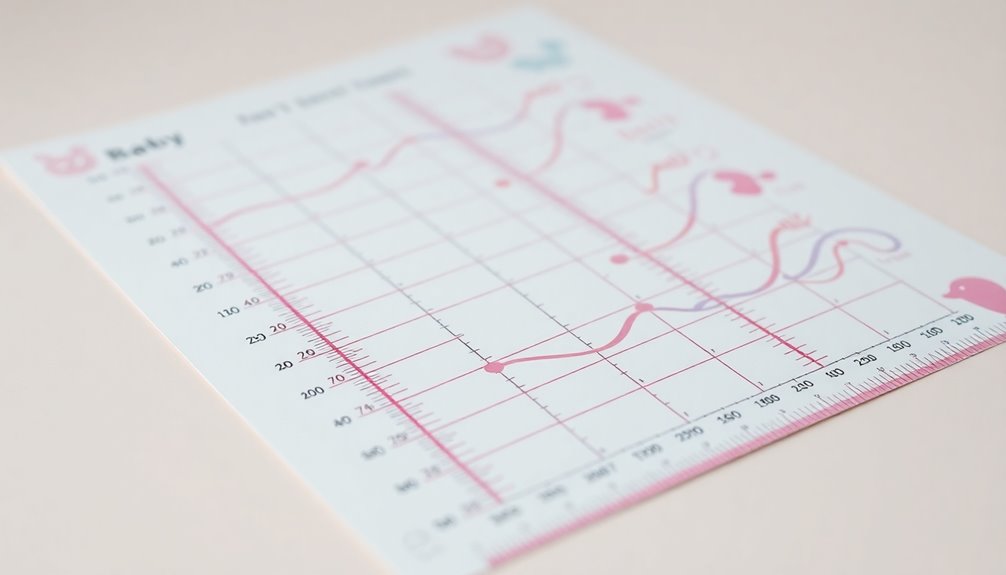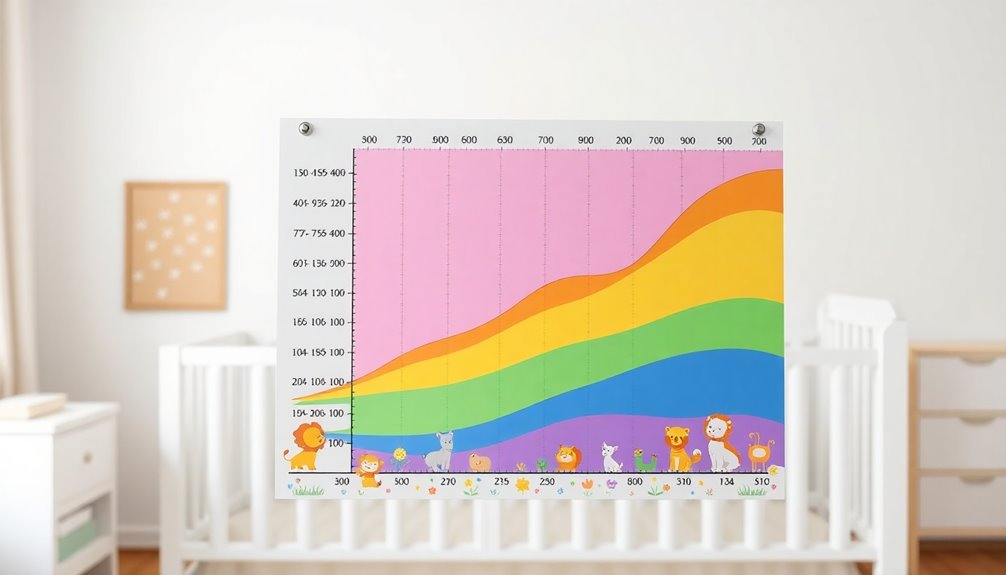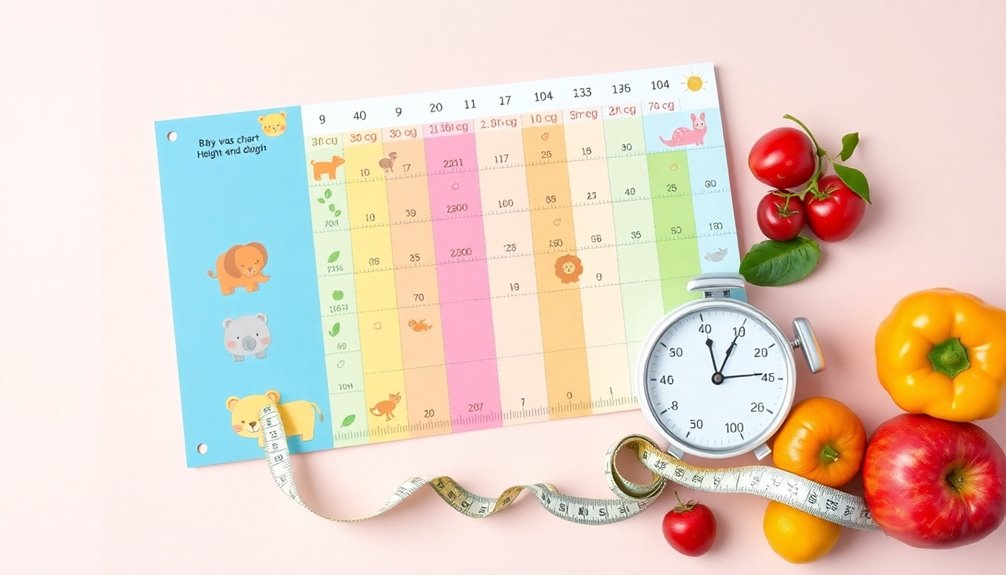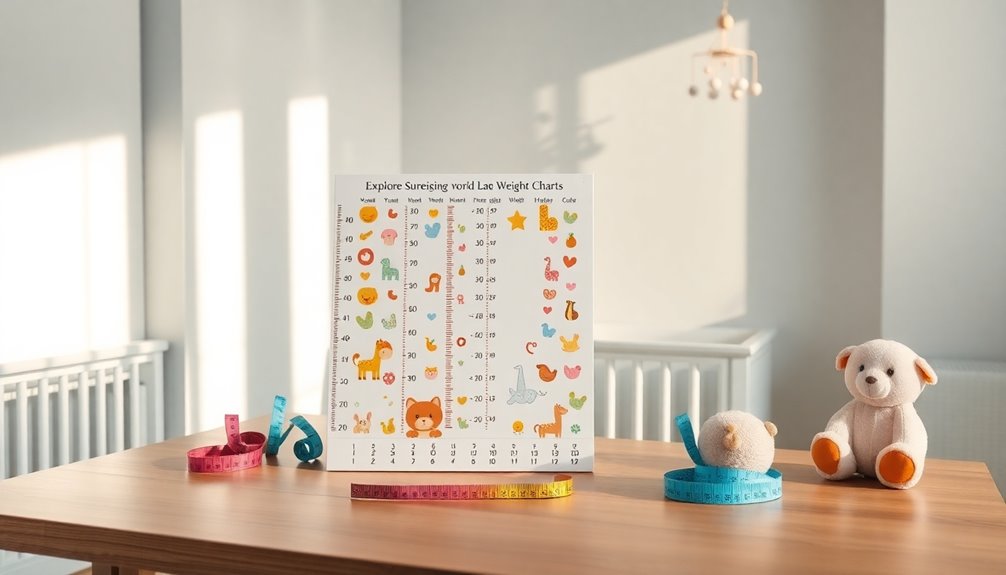If you're shocked by baby height and weight charts, you're not alone! These charts track your child's growth against percentiles, giving you a clear picture of how they compare to peers. Understanding the average weights and lengths for boys and girls can help you monitor development. It's vital to pay attention to growth trends rather than just numbers. Keep an eye on feeding practices, as they greatly affect growth patterns. Discover more insights on ensuring your child's healthy development!
Key Takeaways
- Baby growth charts indicate percentiles, showing how a baby's weight and height compare to peers of the same age and sex.
- Consistent growth patterns are more crucial than exact percentiles for assessing a baby's health and development.
- Average birth weights range from 5.1 to 9.7 lbs for girls and around 7.5 lbs for boys, with varying heights.
- By 12 months, girls typically weigh between 15.0 to 26.5 lbs, while boys range from 16.5 to 27.3 lbs.
- Monitoring feeding practices and regular pediatric visits are essential for tracking growth and addressing any concerns.
Understanding Baby Growth Charts

Understanding baby growth charts is vital for tracking your little one's development. These charts measure weight and height against age and sex-specific percentiles, helping you see how your baby compares to peers.
For instance, if your baby's in the 50th percentile for weight, they weigh more than half of their peers. Remember, consistent growth trends matter more than exact percentiles; a baby in a lower percentile can still be healthily developing.
Pediatricians use updated growth charts that reflect current breastfeeding patterns and monitor any significant drops in percentiles. Regular pediatric visits are important for addressing growth patterns and ensuring your child's development stays on track.
Keep these factors in mind to support your baby's growth journey.
Girls Baby Weight and Height Chart

Tracking your baby girl's growth involves knowing the typical weight and height ranges at various ages. The average birth weight for girls is between 5.1 to 9.7 lbs, with lengths averaging 17.6 to 21.1 inches.
Understanding the average weight and height ranges for baby girls is essential for tracking their growth and development.
At 1 month, girls typically weigh between 6.6 and 12.6 lbs and measure 19.3 to 22.9 inches. By 3 months, their weight usually ranges from 9.7 to 17.2 lbs, while length can range from 21.6 to 25.5 inches.
At 12 months, girls average between 15.0 and 26.5 lbs and 26.8 to 31.5 inches in length. By 4 years old, they typically weigh between 26.0 and 49.8 lbs, with lengths from 36.5 to 44.4 inches.
Monitor your child's growth to guarantee healthy growth.
Boys Baby Weight and Height Chart

As your baby boy grows, it's important to keep an eye on his weight and height to guarantee he's developing healthily.
The average birth weight for boys is about 7 lb 8 oz, with a length of 19.7 inches. At 1 month, boys typically weigh between 7.1 to 13.2 lbs and measure 19.8 to 23.3 inches.
By 3 months, expect weights between 10.6 to 18.3 lbs and lengths of 22.3 to 26.1 inches. At 12 months, the average weight for boys rises to 16.5 to 27.3 lbs, with heights ranging from 27.6 to 32.0 inches.
By 4 years, boys should weigh between 26.9 to 48.7 lbs and measure 37.0 to 44.5 inches.
Tracking these child's measurements helps you understand their weight and height percentile.
The Importance of Percentiles in Growth Monitoring

Monitoring your child's growth through percentiles is essential because it provides insight into how their measurements stack up against peers. Percentiles explained on weight charts indicate where your child stands; for example, a child in the 75th percentile weighs more than 75% of their peers.
While individual percentile positions are informative, consistent growth patterns are vital for evaluating child health. The CDC growth charts help track these patterns, especially regarding breastfeeding patterns.
If your child falls below the 10th or above the 90th percentile, it may signal the need for further evaluation by healthcare professionals. Ultimately, focusing on individual growth curves rather than just percentile ranks leads to a better understanding of your child's overall health and development.
Feeding Practices and Growth Patterns

Feeding practices play an essential role in your baby's growth patterns, especially during the first year of life. Proper nutrition is vital for achieving healthy weight gain and supporting baby growth. Here are some key points to reflect on:
- Breastfed babies usually lose about 7% of their birth weight initially but often double it by 4 months.
- Avoid introducing solid foods before 6 months, as breast milk or formula provides all necessary nutrients.
- After 6 months, introduce nutrient-dense solid foods like bananas and avocados to support development.
- Maintain a balanced diet with adequate breast milk or formula intake for babies aged 6-12 months.
Remember to consult pediatricians for monitoring feeding and addressing any slow weight gain concerns!
Addressing Growth Concerns

When you notice your baby's growth isn't following expected patterns, it's essential to identify potential issues early.
Don't hesitate to seek professional guidance from a pediatrician, especially if your child's measurements consistently fall outside the normal range.
Monitoring your baby's nutritional intake can also help guarantee they're getting what they need for healthy growth.
Identifying Growth Issues
Identifying growth issues in your child can be challenging, especially since a single measurement outside the normal range doesn't always indicate a problem.
However, it's essential to monitor growth patterns over time. Here are some signs to watch for:
- Measurements consistently fall below the 3rd percentile or above the 97th percentile.
- Delays in reaching developmental milestones, like motor skills or social engagement.
- Unexplained changes in height or weight that don't align with expected growth.
- Concerns about your baby's overall health or well-being.
If you notice any of these signs, consult a pediatrician for evaluation and potential early intervention.
Addressing growth concerns promptly can meaningfully enhance your child's health and development.
Seeking Professional Guidance
How can you guarantee your child's growth is on track? To address any concerns about your child's weight or height, it's crucial to consult with a medical professional.
Pediatricians track growth trends, and if your child's weight falls below the 3rd percentile or above the 97th, it could indicate potential health issues. Regular monitoring growth patterns is important, as a single measurement isn't always alarming.
Pay attention to signs of developmental delays, like difficulty reaching motor skills milestones. Early intervention can make a significant difference, so don't hesitate to seek advice from professional groups of doctors.
Monitoring Nutritional Intake
Guaranteeing your baby's nutritional intake is on track is essential for supporting their growth and development. Monitoring your baby's diet, especially between 6-12 months, helps you provide the right nutrients for peak weight gain.
Consider these key points:
- Introduce nutrient-dense solid foods like bananas, avocados, and egg yolks.
- Maintain a balanced diet rich in proteins, calcium, and iron.
- Consult a pediatrician if weight gain is slow, as this may indicate food absorption issues.
- Confirm your baby gets 400-500 ml of milk daily for essential calcium and vitamin D.
Regularly tracking growth patterns against established charts can help you identify potential nutritional concerns early and address them effectively.
The Role of Pediatricians in Tracking Growth

Pediatricians play an essential role in monitoring your baby's growth and development. They use growth charts to track your baby's weight, height, and head circumference, helping identify any potential health concerns.
Regular visits guarantee ongoing monitoring of growth patterns, keeping your child within healthy percentiles, which range from the 5th to the 95th. It's vital to focus on the overall growth curve rather than individual percentile positions, as a steady growth trend is more indicative of health.
If pediatricians notice significant changes, like drops in percentiles, they may investigate further to address underlying issues. By prioritizing these evaluations, they help guarantee your child's growth remains on track for peak development.
Resources for Parents on Baby Growth

As a parent, you can access various growth tracking tools to monitor your baby's development effectively.
Utilizing nutritional guidance resources helps you guarantee your little one gets the right nutrients for healthy growth.
Don't forget that consulting with professionals can provide you with tailored advice and reassurance about your child's progress.
Growth Tracking Tools
Tracking your baby's growth is essential for ensuring they're developing as expected, and there are several helpful tools available for parents. Here are four effective resources to take into account:
- Growth Charts: These charts help you track your baby's weight, height, and head circumference against standardized percentiles based on age and sex.
- Online Calculators: Use child height predictor tools to estimate future growth and assess if your baby is on track.
- Regular Pediatric Visits: Healthcare providers can monitor growth patterns and address any concerns you may have.
- BabyCenter App: This app offers tools for tracking growth milestones and provides educational articles on infant nutrition.
Utilizing these tools can greatly aid in tracking your baby's growth and overall health.
Nutritional Guidance Resources
When it comes to ensuring your baby grows healthy and strong, having the right nutritional guidance is essential. For the first six months, focus on providing adequate breast milk or formula, as this supports your baby's weight gain and overall development.
After six months, introduce nutrient-dense solid foods like bananas and avocados to promote healthy growth. The American Academy of Pediatrics recommends a daily vitamin D intake of 400 IU to aid bone development. Additionally, early detection of any growth concerns can be critical for a child's long-term health outcomes.
Monitoring feeding practices is vital in evaluating your child's height and weight and ensuring they meet nutritional needs. Always seek pediatricians' advice to address specific concerns and understand your baby's growth patterns, ensuring a solid foundation for their future health.
Professional Consultation Options
Ensuring your baby's growth stays on track involves more than just proper nutrition; professional consultation plays a key role. Regular check-ups with a pediatrician are essential for monitoring growth patterns and addressing any concerns about height and weight.
Here are some consultation options to evaluate:
- Pediatrician: Schedule well-child visits to assess your baby's growth trajectory and developmental milestones.
- Lactation Consultants: Seek support for breastfeeding challenges that may affect weight gain.
- Growth Charts: Use these tools to track your baby's growth against established norms.
- Online Communities: Connect with other parents facing similar growth concerns for shared experiences and insights.
Additionally, understanding the importance of monitoring growth can help ensure that any potential issues are addressed promptly.
Frequently Asked Questions
Is 12 Lbs Big for a 2 Month Old?
Is 12 lbs big for a 2-month-old?
It's slightly below average for girls, but right on target for boys, so it really depends on your baby's gender.
Remember, growth patterns matter more than a single weight measurement.
Babies typically regain their birth weight within two weeks and should double it by four months.
If you're concerned about your baby's weight gain, don't hesitate to consult your pediatrician for guidance and reassurance.
What Does It Mean if Your Baby Falls off the Growth Chart?
If your baby slips off the growth chart, it can feel like a sudden storm cloud overshadowing your sunny day.
This drop might signal potential health concerns or feeding issues, so it's crucial to seek your pediatrician's advice.
Remember, a single measurement can't tell the whole story; what matters is the overall growth trend.
Keep tracking those little milestones, and don't hesitate to intervene if something feels off.
Early action can make a big difference!
How Old Is a 20 Lb Baby?
If you've got a 20 lb baby, they're likely between 6 to 9 months old.
At 6 months, boys typically weigh between 15.2 to 22.6 lbs, and girls between 14.1 to 20.9 lbs, so your baby's weight falls in the higher percentiles.
By 9 months, average weights increase, but a 20 lb baby would still be above average.
Consistently monitoring their growth is important, so regular check-ups are recommended.
How Do You Calculate Height and Weight for a Baby?
Calculating a baby's height and weight is as straightforward as pie.
To find the weight, weigh yourself holding the baby, then subtract your weight from the total.
For height, lay the baby flat and measure from head to toe, ensuring their legs are straight.
For head circumference, wrap a flexible tape around the widest part of their head.
Regular check-ups help you track these measurements, ensuring your baby's growth is on track.
Conclusion
As you navigate the world of baby growth charts, remember that every child develops at their own pace. While the numbers can seem intimidating, they're just part of the story. Keep an eye on those percentiles and trust your instincts. If you notice something off, don't hesitate to reach out to your pediatrician. The journey of growth is filled with surprises—some delightful, some concerning—but you're not alone in this adventure. What will your little one's growth reveal next?









